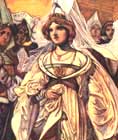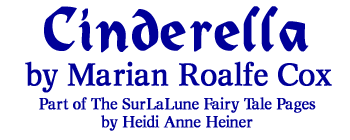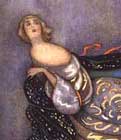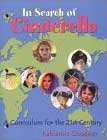
Cinderella:
345 Variants
by Marian
Roalfe Cox
SurLaLune's
Cinderella Area
SurLaLune Fairy Tales Main Page
229
Basile, Der Pentamerone, oder Das Märchen aller Märchen, von Giambattista Basile. Aus dem Neapolitanischen ubertragen von Felix Liebrecht. Breslau, 1846. Vol. i, pp. 379-395. (3rd Day, 10th Tale.)
"THE THREE FAIRIES."
ABSTRACT
Ill-treated heroine (by step-mother)--Heroine
drops basket into dust-hole; asks hideous wild man to recover it; he bids
her descend for it; she meets three fairies; is taken to their house;
does their hair; pleases them; is given choice of dresses; takes the worst
and gets the best; leaves by chief door, and gets star on brow--Step-sister
offends fairies; is sent away empty-handed by back door; gets ass-tail
on brow--Menial heroine (swineherd)
--Grand gentleman sees heroine; wants to marry her; is to return for her
at night--Step-mother puts heroine in cask; presents own daughter--Next
day gentleman would return False bride-- Step-mother away--Animal witness
(cat)--Heroine released from cask; step-sister put in--Happy marriage--Villain
Nemesis. Step-mother boils own daughter; drowns herself.
TABULATION
(1) A wicked widow named Caradonia, whose daughter Granizia is the quintessence of hideousness, marries the wealthy Micco Antonio of Pane Cuocolo. He has a daughter named Cecella, a marvel of beauty, and such a striking contrast to widow's daughter that jealous stepmother treats her with every possible indignity. She is dressed in rags, given the worst food, and made to do all the menial work of the house and stable; while stepsister is idle.-- (2) One day when she goes out to empty sweepings into immense dust-hole she accidentally drops her basket, and whilst considering how to recover it, sees a hideous horror, with pitch-black hair like hog's bristles reaching down to his heels, a terrible countenance, a hump-hack, thin legs, and crooked feet-- enough to scare anybody. Cecella takes courage and says, "Kind man, would you pick out my basket! You'll get a wealthy wife!" The wild man tells her to step in and get it herself.-- (3) She climbs down into the hole, and sees three beautiful golden-haired fairies, who caress her and lead her to their splendid house, then set her to comb their hair. Asked what she finds, she replies, "Little flits and little lice, like pearls and garnets." Fairies are pleased with her; show her all the treasures in their palace. They bid her choose what she will of gorgeous dresses and jewels. She disregards the costly things and takes a worthless rag of a gown. Fairies ask at which door site will go out; she chooses back way; they embrace her, deck her out in gold-embroidered robe, and dress her hair; lead her to golden portal, bless her, and bid her look up. Gold star falls on her brow.1 She goes home; tells stepmother everything.-- (4) Stepmother sends own daughter to fairies, she offends them when doing their hair "Every louse is as big as your fist and every nit like an egg." She grasps at the costliest dresses, and wants to leave by the best door. Fairies send her empty-handed to back door, and bid her look up and see what will happen. She gets an ass's tail on her brow.-- (5) Stepmother is furious; despoils heroine to dress own daughter, and sends heroine in rags to tend swine. She falls in with a distinguished gentleman named Cuosemo, who is struck with her beauty, inquires who she is and where she lives, then goes to get stepmother's permission to marry her. Stepmother bids him return that evening, as she wishes to invite her relatives.-- (6) Meanwhile she puts heroine into cask, meaning to scald her to death, and when bridegroom returns gives him her own daughter, who is hideous spite of fine clothes. Cuosemo is aghast and bewildered at the change, and can scarce endure to kiss the revolting creature. As his home is afar and it is night, he takes her to a house hard by. As soon as it is morning he hurries back to stepmother's to say he will be quit of her daughter, and to pay her the forfeit with a broomstick.-- (7) Stepmother is not to be found, having gone to gather sticks to prepare boiling bath for stepdaughter. He calls, and cat in the ashes says, "Miaow, miaow, your bride is in the cask!" He goes to cask and hears a sobbing, gets an axe, and releases heroine. She tells him all that has befallen her; he bids her hide behind door, whilst he repairs cask, fetches false bride, and puts her inside it. Then he rides off with Cecella behind him.-- (8) Stepmother returns; boils own daughter; drowns herself in the well in her rage and despair on discovering her mistake.
NOTES
Note 12
(P. 163.) For "star on brow", cf. D'Aulnoy, "Belle Etoile"; Blade, Contes agenais, p. 149; Cosquin, i, 186 (heroine has gold star on her chest); Crane, pp. 18, 101; Day, Folk-tales of Bengal, pp. 236 ff., 242; Frere, O. D. D., 88 ff., 136, 140, 255; Gonzenbach, No. 5; Grimm, Nos. 9, 96; Gipsy-lore Journal, iii, 83; Melusine, 1877, col. 206, 214; Romero, No. 2; Stokes, pp. 1 ff., 119, "The Boy who had a Moon on his Forehead and a Star on his Chin," 158 ff.; Straparola, No. 3; Webster, pp. 54, 60; Wide-Awake Stories, p. 310. See also Nos. 21, 131, 174, 194, 201 (gold cross), 202, 229, 232, 237, 240, 241, 245, 247, 339, 365 of this collection. (Compare Pedroso, No. xv, "The Maiden with the Rose on her Forehead.")
The Dioscuri had a star or flame shining on their heads and helmets. Figures of Greek divinities show a circle of rays and a nimbus round the head. Apis is represented as a bull, with a star above his head, on the brass coins of Julian the Apostate. On coins of Tyre and Sidon Astarte is figured with a radiated head. A bust on a Saxon Sceatta (unappropriated) appears to have a star on the forehead. On Indo-Grecian coins Mithras has commonly a circular nimbus with pointed rays; in other representations the rays are wanting. Mao (deus Lunus) has a half-moon behind his shoulders; AEsculapius, too, had rays about his head, [Greek name] (Asklepios), Paus., ii, 26, 4. Compare the aureoles of Christ, the Virgin, and Christian saints, and the crowns and diadems of kings. See Grimm, Teut. Myth., 323. A ring of stars was put round the head of Thor (Stephanii not. ad Saxon. Gram., p. 139). According to a story told in the Galien restore, a beam came out of Charles the Great's mouth and illumined his head. Certain Slavic idols, especially Perun, Podaga, and Nemis, have rays about their heads; and a head in Hagenow, fig. 6, 12, is encircled with rays, so is even the rune "R" when it stands for Radegast.
In illustration of a recently-practised custom of adorning the face of a bride with stars, I quote the following from a paper by "Adalet", on "Turkish Marriages, viewed from a Harem", which appeared in Nineteenth Century, July, 1892:--"Till some time ago a very strange addition was made to the Turkish bride's dress--four diamonds chased in gold being stuck on her cheeks, forehead, and chin, by a sort of gum, which held them there for some time. The writer once saw a bride thus dressed, but now the custom has become obsolete, or is confined to the lower classes."
The story on p. 163, like Nos. 1, 2, 5, 8, 21, 60, 89, 90, 118, 119, 237, 239, 240, 241, 245, 247, 300, 301 of this collection, is allied to the type represented in Grimm's "Mother Holle", and Perrault's "Les Fees", in which the heroine is rewarded for industry or kind services, whilst her sister or stepsister is punished for churlishness or greed. Cf. also the following:--American F.-L. Journal, i, 144; Bechstein, pp. 63-66, "Die Goldmaria und die Pechmaria"; Ben'ey, Pant., i, 219; Blade, Contes agenais, p. 149; Callaway, Z. T., p. 219; Chodzko, p. 315; Clouston, Pop. Tales and Fictions, i, 105, 366; Coelho, No. 36; Cosquin, No. 48, and notes; Crane, p. 100 (and for other Italian versions, p. 346); Dasent, 113, 322; Finamore, pp. 65-9, No. xv, "Fiore e Cambedefiore"; F.-L. Journal, , 282ff.; Grimm, Nos. 13, 15, 24, 36, 40, 47, 56, 64, and see i, 369-70; Henderson, Northern Counties, p. 349; Karajich, No. 36; Landes, No. 72; Melusine, i, col. 43; Monseur, Folklore Wallon, p. 48; Nat. Rev., 1857, v. 398, 399 (story of Fo); Prohle, ii, No. 5; Romania, No. 32, p. 564; Sagas from the Far East, p. 151; Schambach und Muller, Niedersachsische Sag. u. Mar., No. ii, pp. 276-8; Sutermeister, pp. 7-10; Theal, Kaffir F.-L., p. 49; Vernaleken, pp. 155-167.
The heroine is generally requited with gold. See note
51.
Return to place in text.
Cox, Marian Roalfe. Cinderella: Three Hundred and Forty-five Variants of Cinderella, Catskin, and Cap O' Rushes, abstracted and tabulated. London: David Nutt for the Folklore Society, 1893.
While the original text of this book is out of copyright, the special formatting and compilation available on SurLaLune Fairy Tales is copyrighted. Be aware that while the original content has been honored, page numbering, footnote numbering, redesigned charts, links, and other aspects are unique to this site's version of the text. Use at your own risk. For private and fair use educational purposes only.
©Heidi
Anne Heiner, SurLaLune Fairy Tales
E-mail: surlalune@aol.com
Page last updated February 1, 2006
www.surlalunefairytales.com










